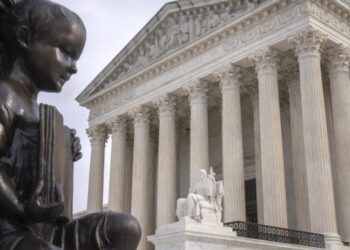The fate of Texas’ and perhaps California’s recent redistricting — and thus the political composition of the House of Representatives after the 2026 midterm elections — turns on a principle of law that’s never made much sense before and makes absolutely no sense now.
The “Purcell principle” states that federal courts cannot impose changes in election rules too soon before an election, even by finding them unconstitutional. As applied here it would mean that state governments could effectively change election systems just before voting day, in blatantly unconstitutional ways, and no court would be able to stop it. That just can’t be right.
The context of this spurs from when the Texas Legislature, at the urging of President Trump, redrew its congressional districts in October in an attempt to create five more districts where Republican candidates are likely to prevail. Last week, a three-judge federal court, in a 2-1 decision, found that the new districts violated equal protection in their discrimination against voters of color and issued a preliminary injunction against their use in the election.
In a 160-page opinion, federal Judge Jeffrey Brown concluded that, “Substantial evidence shows that Texas racially gerrymandered the 2025 Map.” The court ordered the state instead to use the map the Texas Legislature previously adopted in 2021 for the 2026 midterm elections.
On Friday, the state of Texas filed a brief in the U.S. Supreme Court invoking the Purcell principle. The state argues that the federal court’s decision “comes far too late in the day under Purcell” because the deadline for candidates to file ahead of next year’s elections, Dec. 8, is just 17 days away. The state added that its primary election is scheduled for March 3, 2026, “with early voting beginning on February 17, 2026, less than three months from now.”
However, this ignores that Texas Gov. Greg Abbott signed the bill creating the new districts on Oct. 25. A legal challenge to the districts was filed immediately. The three-judge court handled the matter with great speed and produced a lengthy decision in less than a month. In fact, Judge Jerry Smith wrote an angry 104-page dissent, objecting especially to the speed with which the majority released its decision, which the majority said it was doing specifically to avoid problems with the Purcell principle.
The Supreme Court handed down its order on Purcell vs. Gonzalez in 2006 without any briefing or oral argument. A federal court of appeals had found that a new Arizona election law requiring voters to show photo ID at the ballot box violated the right to vote under the 14th and 15th amendments, and the appellate court stopped it from going into effect. But the Supreme Court allowed the Arizona law to go into effect for the immediate election.
“Given the imminence of the election and the inadequate time to resolve the factual disputes,” the court’s decision read, “our action today shall of necessity allow the election to proceed without an injunction suspending the voter identification rules.”
The constitutional basis for this never has been explained by the Supreme Court. Why should unconstitutional or illegal restrictions on voting be put into effect just because the challenge is being heard so soon before the election? Nonetheless, the court has invoked Purcell vs. Gonzalez a number of times.
For example, in Republican National Committee vs. Democratic National Committee in 2020, a federal district court in Wisconsin issued an order five days before the scheduled election stating that absentee ballots mailed and postmarked after election day, April 7, would still be counted so long as they were received by April 13. The judge issued this order because of the increase in absentee ballots in April 2020 at the height of concern over the COVID-19 pandemic.
Wisconsin law had previously required that ballots be received by election day. The federal judge’s order made great sense because otherwise many ballots would never have been received in time to be counted through absolutely no fault of the voter. The Supreme Court, though, in a 5-4 ruling, overturned this order based on Purcell.
The court has yet to adequately make clear how close to an election decisions must be made to justify the application of Purcell. In 2022, in Merrill vs. Milligan, the court applied Purcell to stop a judicial challenge to new election districts nine weeks before a primary. After the 2020 census, the Alabama legislature drew new maps to pack almost all of the state’s Black voters into one district so that, although Alabama’s population is 27% Black individuals, only one of seven congressional districts had a Black majority.
Following a seven-day hearing, the three-judge panel — which included two judges appointed by Trump and one appointed by President Clinton — found that the congressional districts drawn by the Alabama legislature likely violated the Voting Rights Act. But the Supreme Court in a 5-4 ruling, with Chief Justice John G. Roberts Jr. joining the three liberal justices in dissent, stayed the lower court ruling based on the Purcell principle and allowed the discriminatory Alabama map to be used in the 2022 elections.
Strikingly, none of the nine justices, including those in the majority, disagreed with the lower court’s conclusion about the discriminatory effect of the Alabama legislature’s districting. In fact, in June 2023, the Supreme Court ultimately found that the lower court was right and that Alabama had violated the Voting Rights Act.
If the Supreme Court agrees with Texas that the Purcell principle bars a constitutional challenge to the new Texas congressional districts, it no doubt also would mean that there cannot be a challenge to the new California districts, which the voters approved this month by passing Proposition 50.
But the Purcell principle is always troubling when it allows unconstitutional election laws to go into effect. It is just wrong when it means a state can act unconstitutionally but be completely immune from challenge.
Erwin Chemerinsky is the dean of the UC Berkeley Law School.
The post This Supreme Court loophole could help Texas’ illegal voting maps survive the midterms appeared first on Los Angeles Times.




